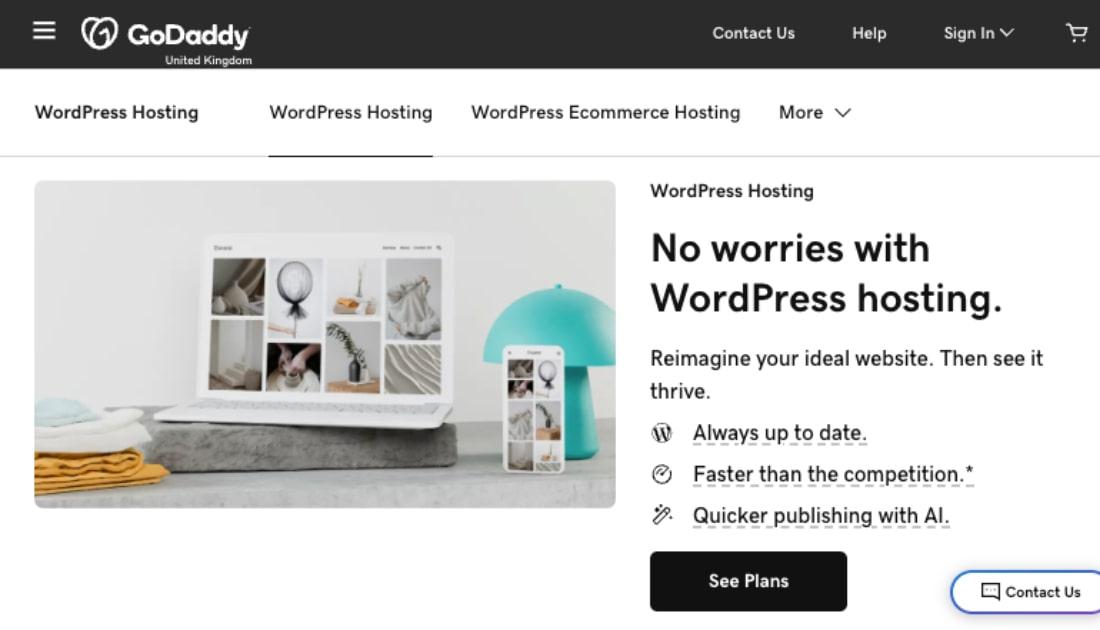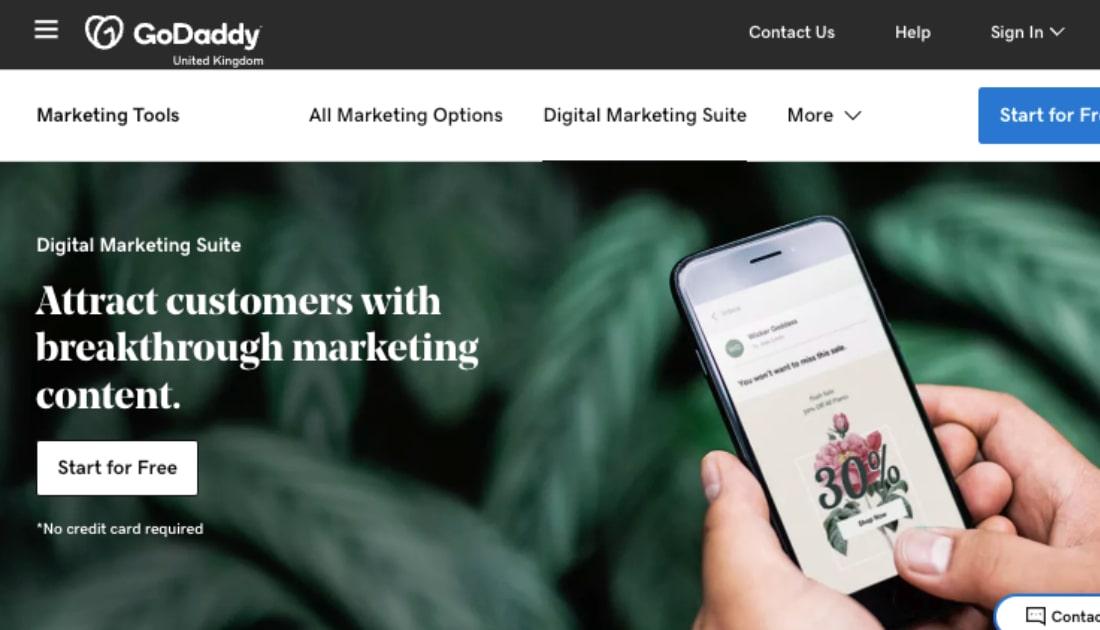Some bloggers do it for fun, other bloggers do it to make money. Earning a living from a blog is difficult, but it’s also possible.
In this guide, we’ll look at the basics of getting a blog up and running, and some methods you can use to monetize it on the path to turning blogging into a full-time income stream.
- Choosing the right blog platform when monetization is important
- Choosing a topic for your blog
- Planning your blog’s design and features
- Creating and publishing your content
- Promoting your blog
- Ways to monetize your blog in 2023
1. Choosing the right blog platform when monetization is important
When starting a blog with the aim of making money it may be tempting to use a free blogging platform. Don’t. Almost all successful bloggers avoid free platforms for a very good reason.
Using a free blog platform will severely limit your options when it comes to monetization, so it’s something you should avoid when creating your own blog. You can learn more about why you shouldn’t use a free blogging platform in this guide.
So, if free blogging platforms are out of the question, what should you use to set up your blog?
Well, there are plenty of options out there, but you’re likely to find that WordPress is the easiest to use. It’s extremely popular with bloggers and there’s plenty of support available.
Like most hosting companies, GoDaddy offers specialist WordPress hosting packages, which takes all the hassle out of getting your blog up and running. And if you opt for an annual plan, you’ll also get a free domain name. You don’t need to spend a fortune on web hosting when you’re starting out, a basic package should be enough to get started. You can always upgrade your web hosting as your blog grows.
On the subject of domain names, you need to pick one that’s short and relevant to what you’ll be blogging about.
It might be something as simple as your name (if your name is still available as a domain name), or it might be a clever name that relates to your chosen blogging niche.
Whatever you pick, you need to ensure the domain name will be relevant to your blog now and in the future.
Make sure you have a solid idea what you’ll be writing about before you buy your domain (see below). However, aspiring bloggers shouldn’t get too hung up on choosing the perfect domain name, one that’s good enough will do.
You can find more advice on what makes a good domain in this guide.
And you can search for a domain name below.
2. Choosing a topic for your blog
It can be tempting just to blog about anything and everything, but the most successful blogs in terms of monetization are focused on a specific niche.
To identify a profitable niche for your blog you should look at the potential income from advertising and affiliate programmes (see below). What kinds of thing will your target audience spend money on and how much money do they spend? If there are plenty of opportunities available, you’ll have a chance of making money from your blog content.
You should also consider blogging in a niche you’re interested in and already know about. This will make it easier to come up with blog topics and make it more likely that you’ll keep blogging through the early days when you’re not making any income.
You may also want to base your blog name and domain on the niche you choose.
3. Planning your blog’s design and features
One of the best things about WordPress blogs is how easy they are to customize. Although you can use a pre-designed template to get your blog up and running quickly, you’ll probably want to spend a bit of time working out exactly how you want your blog to appear to readers.
Some things you’ll want to consider are:
- Will I be posting a lot of photos and/or videos?
- Do I want custom graphics (such as a blog logo) on my blog?
- How do I want my blog homepage to look?
- What do I want my site navigation to be like? (This won’t matter too much when your blog is small, but planning your navigation early on can avoid headaches further down the line).
Once you’ve decided what you want from your blog, you can then go out and find a suitable theme. (WordPress themes dictate the look and features of your site.)
Beginners may find one of the free templates offered by GoDaddy is perfect for their blog, but if you want something a little more advanced, you’ll have to pay for a blog theme, so make sure you pick one that matches your needs exactly. You can find a wide selection of themes of Theme Forest and Template Monster.
Of course, you can always stick to a basic free template while you get started with your WordPress blog and then change things later on. Beginners can start small and grow, and of course you can change the design of your blog as often as you want (although as your blog gets bigger, this may take more effort.)
In terms of navigation, you’ll want to make sure things 1) make sense to readers and 2) doesn’t go deeper than two or three layers. For example, you could decide to blog about Topic A, Topic B, Topic C and Topic D and then have a navigation menu which includes each of those topics as clickable links. Visitors will then be able to browse posts on the topic that interests them most just by clicking a link. WordPress makes it easy to design your blog this way, but make sure it’s something you think about when setting things up.
Another big advantage of WordPress is that you can use WordPress plugins to add new features and functionality to your website when needed.
4. Creating and publishing your content
We’re going to assume you already have a good idea of the general topic of your blog. If not, this guide will help you decide what to blog about.
We’re also going to assume you’re able to get to grips with actually publishing articles on WordPress by yourself. (If you need some help, check out this guide to publishing WordPress articles.)
What we’re going to focus on in this section is the importance of publishing regular content to your blog.
You don’t have to publish every day (though if you can, that’s great, but you should aim to publish at least once a month (ideally more).
Leaving a long gap between posts can make it harder to build up an audience. You also run the risk of grinding to a halt completely, as a long gap can keep getting longer.
To help avoid this, develop a content calendar and keep it full of ideas. You can learn about creating a content calendar here.
You should also aim to finish articles well ahead of time where possible. WordPress allows you to schedule posts for a future date, allowing you to stick to your calendar even when you’re not in front of your computer.
Often when you start blogging, it can be a good idea to get your first blog post written quickly and just keep going. That way, you’ll be up and running rather than just planning out future content. Once you’ve started, you can write and schedule new posts in advance.
It takes a lot of hard work to make money from blogging and new bloggers often give up before they start generating income.
You also need to be realistic about how much you can earn. Although many successful bloggers work on their content full-time, you’ll have to earn a lot of money before you can afford to do this. You might be better off viewing your blog as a side hustle you can grow.
5. Promoting your blog
Any form of blog monetization requires you to attract readers and to do that you’ll need to promote your blog. In this section, we’ll briefly cover the main ways you can attract readers and link to more in-depth guides. You should employ a range of digital marketing techniques to increase your chances of attracting readers. Remember, the more readers you attract the better your chance to make money online.
Before you start promoting your blog, it’s important you understand the traffic you’re getting. For that reason, it’s a good idea to install Google Analytics on your blog before you start creating and promoting your blog posts. It’ll help you track the number of visitors your website gets, so you know where you are on your blogging journey.
Search engine optimization
Search engine optimization (SEO) is hugely important for any website. Good SEO is the key to ensure your website can be found via search engines. There’s a lot to consider, from site structure to keyword research. Any successful blog is likely to have good rankings in Google search results.
Ranking well in search engines will be particularly important if you’re planning to generate income through affiliate links (see below) as you’ll need to identify the right keywords so people interested in the products you mention on your blog will see your site when they search online.
You’ll want to identify keywords that relate your chosen niche and have low levels of competition as this will increase your chances of ranking well for them. You can use an SEO team to help you identify the right keywords.
Don’t expect your new blog to top the rankings straight away, it can take up to a year to see real results from SEO. But make sure it’s part of your planning process from day one.
You can learn about getting started with SEO in this guide.
Social media
Growing a social media following is a great way to attract an audience to your blog, but it’s not easy to do.
Identifying the places where people who are interested in what you write about is a good place to start.
It’s probably easiest to do this on Twitter as it attracts a wide range of people with a wide range of interests. At the very basic level, you can use hashtags to identify people with shared interests. You can also use specialist tools to identify influencers who talk about the subjects covered by your blog. This is another great way to get your content in front of the right audience.
You can learn about how to get started with social media in this guide, while this guide covers getting started with influencer outreach.
Blog commenting
Blog commenting has something of a bad reputation because it’s often used as a spam tactic. But done the right way, commenting on other people’s blogs can be a great way to build relationships within the blogging community and get your content in front of a new audience.
Always make sure any comments you leave are relevant and insightful. If there’s the option to leave a website address as part of a comment, feel free to include your blog’s homepage. But only link directly to one of your blog articles in a comment if it’s 100% relevant to the discussion.
You can learn more about promoting your blog through blog commenting in this guide.
Email marketing
Email marketing can’t really help you attract new readers to your blog, but it can help you keep existing readers coming back for more.
By encouraging people to sign up for your email newsletter, you can ensure a regular flow of engaged and loyal readers. You can also directly contact your email list with things like affiliate offers (see below). However, you’ll need to make sure that any emails you send comply with data protection rules.
To do this, you’ll need a tool like email marketing from GoDaddy. This guide covers the basics of getting started with email marketing.
6. Ways to monetize your blog in 2023
If you want to use your blog to make money online, you’ll have to take some active steps to add monetization to your website. There are a number of options available to you.
It’s likely that you’ll want to use more than one monetization strategy as this will increase your chances of earning money from your blog. Don’t expect to start earning any sort of passive income from your blog until at least a year has passed. And even then, you’ll still need to keep adding new content and updating old posts or your income could start to fall. A profitable blog is an active blog. Make sure you are also easy to reach for collaborations, like a real business, for more credibility and a touch of professionalism it’s useful to have a professional email address that matches your blog name, instead of a generic one.
Include adverts on your blog
When people think of monetizing a blog, they’re generally thinking of making money through including adverts on a blog.
The main way to do this is by using a service like Google AdSense. AdSense allows publishers to include ads on their site which are targeted based on your site’s content and audience.
You can learn about getting started with AdSense here.
It’s important to be realistic about how much income you’ll be able to generate via ads. You’re probably going to need to attract tens of thousands of visitors (if not more) every day to generate a significant amount of revenue.
One method you can use to increase your chances of making money from blogs adverts is choosing a niche which offers high returns on ad clicks, such as financial services or high-value purchases. However, because of the rewards on offer in such sectors, competition for traffic can be fierce and you may struggle to attract a readership.
Affiliate marketing
You might not know the term affiliate marketing, but you will have undoubtedly visited websites that make money using it.
Affiliate marketing works through a business rewarding people who attract customers on its behalf.
For example, if you were to join the Amazon affiliate programme, you’d be rewarded every time someone bought a product because you mentioned it in one of your blog articles.
These sales are usually tracked by the means of a special affiliate link which is unique to you. (So you’ll only get your reward if someone buys after clicking through to the site via your tracking link.)
A huge number of companies offer affiliate programmes, so it should be easy to find one that matches the topic of your blog.
If you can find an affiliate niche that looks particularly lucrative, you may even want to set up a blog focused entirely on that subject.
You can learn more about how to make money with affiliate marketing in this guide.
A note about data protection: Both advertising and affiliate marketing track your website visitors, so make sure that any monetization methods you use comply with data protection rules.
Other ways you can indirectly monetize a blog include launching a consultancy service based on your blog (this is particularly useful if you’re blogging on business-related topics).
Turn your blog into an ecommerce store
It’s less common to make money from a blog by adding an ecommerce store, but it is possible. You might want to launch your own products, or you might want to sell other people’s products that are connected to your blogging niche.
Don’t forget, you don’t have to sell physical products - digital products such as ebooks and online courses can also supplement your blog income.
You can learn more about setting up an ecommerce website in this guide.
Sponsored posts
Once your blog is getting a good level of blog traffic, there’s a chance to earn income from sponsored posts. This is when a brand pays you to write about their product or service. You’ll have to be attracting large numbers of visitors to make any real money from sponsored posts and you’ll also need to be open and honest about any promotions you run on your blog. Always declare sponsored content or you could end up in legal trouble.
Once your blog is established, you may find brands contact you directly (so be sure to include contact details or a contact form and let them know you’re open to promoting products), but you can also use services like to find possible sponsored post opportunities. Sponsorships such as these probably won’t make you rich, but they can provide a decent stream of income.
Summing up
Launching and monetizing a blog in 2023 is still possible, but it isn’t easy. You should approach the launch of a moneymaking blog in the same way as any other small business. Plan, launch a minimum viable product as soon as possible and then aim for growth. Your initial focus should be on building a blog that features high-quality content and attracting readers. Then you can start to look at ways of generating an income from your blogging.







